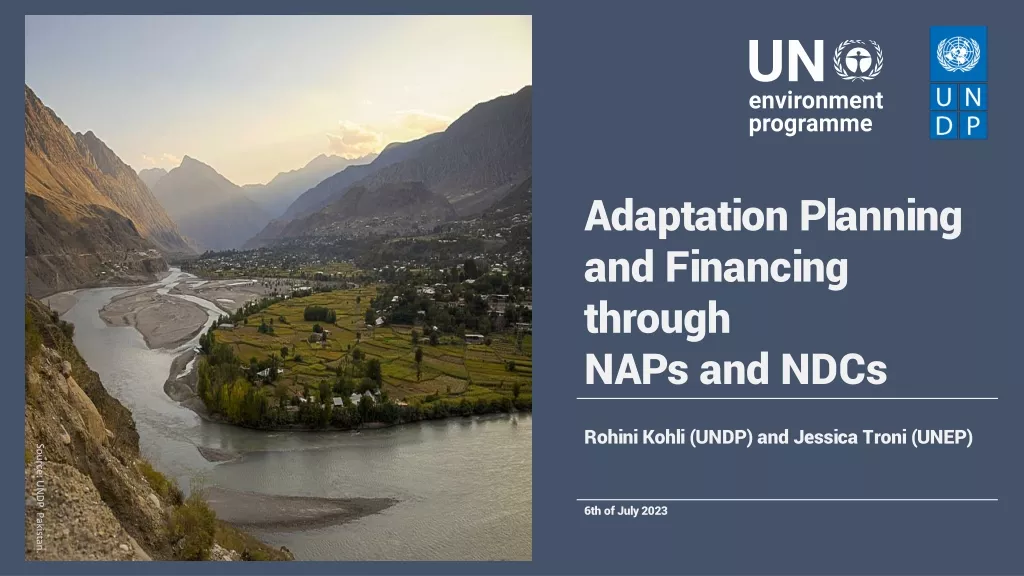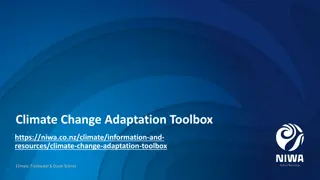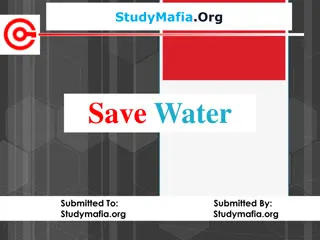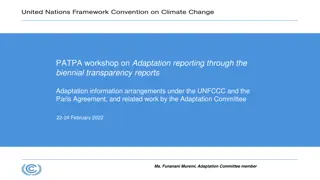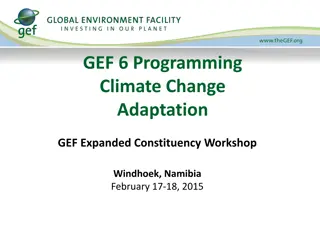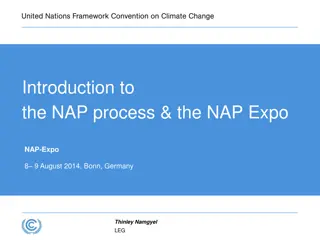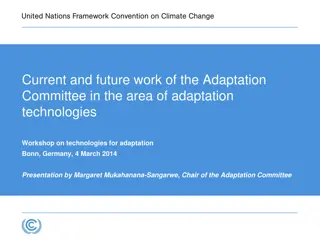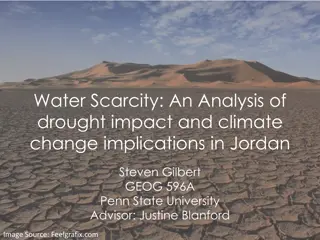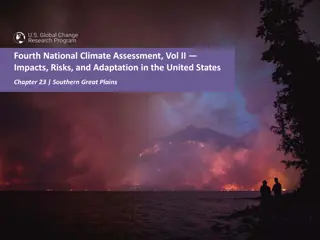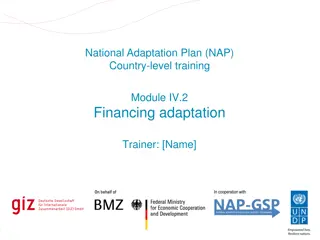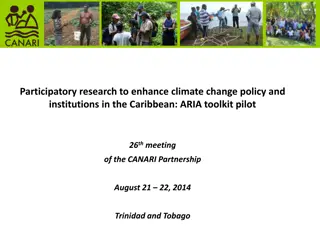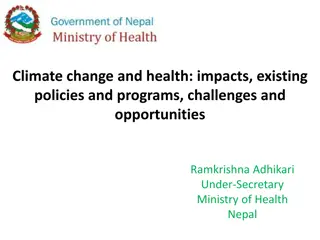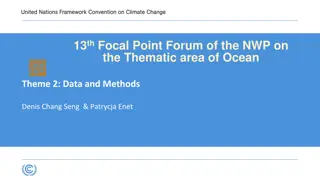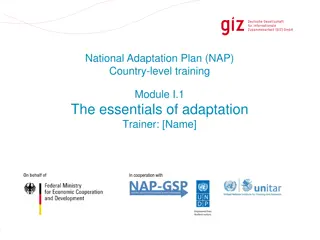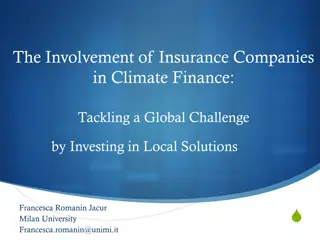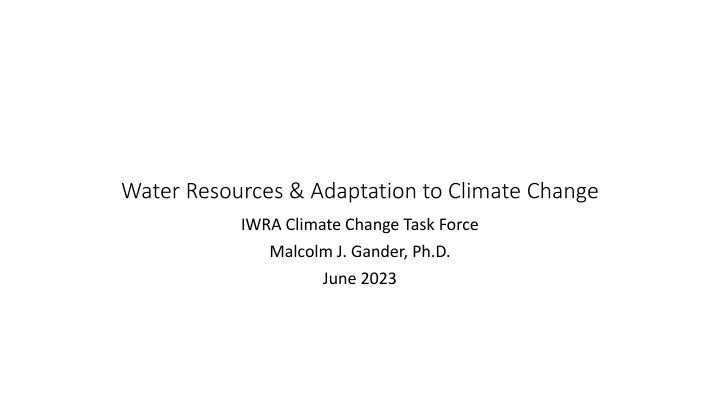
Water Resources & Adaptation to Climate Change Challenges
Our water resources are at risk due to population growth, increased agricultural production, and climate change impacts. Learn about the factors contributing to water resource depletion and degradation, as well as adaptation strategies to combat these challenges. Explore topics such as climate change effects on water availability, adaptation approaches, and sustainable practices.
Download Presentation

Please find below an Image/Link to download the presentation.
The content on the website is provided AS IS for your information and personal use only. It may not be sold, licensed, or shared on other websites without obtaining consent from the author. If you encounter any issues during the download, it is possible that the publisher has removed the file from their server.
You are allowed to download the files provided on this website for personal or commercial use, subject to the condition that they are used lawfully. All files are the property of their respective owners.
The content on the website is provided AS IS for your information and personal use only. It may not be sold, licensed, or shared on other websites without obtaining consent from the author.
E N D
Presentation Transcript
Water Resources & Adaptation to Climate Change IWRA Climate Change Task Force Malcolm J. Gander, Ph.D. June 2023
PowerPoint Orientation Our H2O resources are being increasingly exploited by many factors including population growth & increased agricultural production; we are using more H2O than the amount being replenished Climate change poses compounding factors in the depletion of H2O resources, and degradation of H2O quality What are these factors? What are the adaptation approaches that can be implemented to counteract H2O resources depletion and H2O quality degradation?
Fundamentals of Climate Change & H2O Resources Higher average T & changes in precipitation, T extremes, and prolonged drought are already affecting the availability of H2O resources through changes in rainfall distribution, soil moisture, glacier and ice/snow melt, and river and groundwater flows (UN Water 2022). Higher T also trigger increases in diseases, e.g., malaria. CC influences when, where & how much rain falls. Higher global Ts cause water to evaporate in larger amounts, resulting in more atmospheric water vapor leading to more frequent & intense storms & flooding
7 Adaptation Strategies 7 Adaptation Strategies- -Main Message of Presentation Main Message of Presentation Sea level rise, extreme storm events causing more runoff and less aquifer recharge, and extreme heat waves are manifestations of climate change. The following are adaptation strategies that can counteract these climate change realities: 1)Protect Coastal Wetlands: Salt marshes, mangroves & seagrasses are marine coastal ecosystems that naturally filter water; act as a buffer against sea level rise and storm surges & floodwaters, & store tons of carbon in their roots and soil. 2) Promote Sustainable Agroforestry: This is the integration of diverse trees or shrubs with diverse blend of crops & simultaneously raising livestock using significantly less land & less H2O for irrigation. 3) Decentralize Energy Distribution: Global warming adversely affects grid reliability. Large, centralized power plants/infrastructure are more vulnerable to extreme heat or prolonged cold weather in the winter months that can cause brown outs or power failures from stressed large power plants.
Adaptation Strategies Adaptation Strategies continurd continurd) ) 4) Secure Indigenous Peoples Land Rights: Indigenous communities manage almost 50% the earth s land surface, & up to 2.5 billion people depend on this land for their livelihoods. - These communities have practiced adaptation principles for generations. -Where indigenous people do have legal rights to their land, deforestation is at least two times lower than similar areas 5) Improve Mass Transit: -Road transport accounts for 72% of global transportation-related emissions. -Significant disruptions to transportation infrastructure can be caused by climate change-induced extreme storms & heat. -Low-carbon mass transit will help relieve disruptions. 6) Agricultural Optimization Strategies - Improve on-farm soil and water management through modifying tillage regimes, or utilizing mulching ot lower evaporation. 7) Counteract temperature pollution in streams and rivers by planting more trees to shade/cool waterways
Fundamentals of Climate Change & H2O Resources Excess runoff from extreme storms will collect excess nitrogen & phosphorus from fertilizers & deposit these nutrients into water bodies (eutrophication), causing algal blooms of green, blue-green, red, or brown algae (National Geo 2022). -Toxins from the blooms kill fish & other aquatic animals -Toxins can also survive purification processes of drinking water, causing human sickness Large glacier melt-off at accelerated rates results in less surface water for drinking & agriculture in lower elevations, & more runoff & less aquifer recharge. The increased runoff raises sea levels, inundating coastal cities & requiring costly repairs/changes to infrastructure.
Temperature Pollution, Climate Change, & Ecosystem Degradation Temperature pollution, or thermal pollution, is the degradation of H2O quality by any process that changes ambient H2O temperature It could result in lower T from the release of cold water from large impoundments or industrial facilities, or higher T from solar radiation Example: In Seattle/Washington, too many trees have been cut along streams & rivers, allowing solar radiation to increase H2O T -Warm streams harm salmon by reducing oxygen and allowing diseases and bacteria to spread This adversely affects not only salmon but other species dependent on them, such as Orcas whales (and humans) Global warming/climate change exacerbates the increasing T problem
Distressed Columbia River Salmon Washington, Pacific Northwest, USA
Realities of H2O Resources Management Challenges Data sharing between nations needs improvement Data sharing/interdisciplinary scientific collaboration (Molden et al 2022) throughout either regions within a country or between neighboring nations - can help cooperatively manage surface H2O shortages in the dry season; flooding/storage problems in rainy season; and potentially ease groundwater overpumping Formalized collaboration between water-sharing nations
Adaptation via Nature-Based Solutions It has been estimated that global crop production could be increased by nearly 20% as a result of on-farm soil and water management practices in rain-fed agriculture alone (e.g., improved water harvesting through modifying tillage regimes or mulching)
Adaptation to Climate Change Requires Better H2O Management Adaptation approaches will require additional funds Upgrade infrastructure to: -prepare flood-prone areas in floodplains by expanding floodplains or preserving wetlands or constructing levees/artificial embankments -prepare coastal cities for inundation from sea level rise -prepare wastewater treatment systems and sewage systems for inevitable overloads from flooding/monsoons -counteract temperature pollution in streams and rivers by planting more trees to shade/cool waterways
7 Strategies for Climate Change Adaptation (World Resources Institute 2020) 1)Protect Coastal Wetlands: Salt marshes, mangroves & seagrasses are marine coastal ecosystems that naturally filter water; act as a buffer against sea level rise and storm surges & floodwaters, & store tons of carbon in their roots and soil. 2) Promote Sustainable Agroforestry: This is integration of diverse trees or shrubs with crops and livestock. Pastures with trees sequester 5 10 times more carbon than treeless areas of the same size. Farmland can be more productive by growing a diverse blend of crops & raising livestock simultaneously using significantly less land & less H2O for irrigation. 3) Decentralize Energy Distribution: Global warming adversely affects grid reliability. Large, centralized power plants/infrastructure are more vulnerable to climate change-induced weather events that can interrupt the grid power transmissions. Decentralized systems powered by renewable energy with shorter transmission lines and smaller distribution areas are more climate-resilient and can recover from disasters more quickly.
5 Strategies for Climate Change Adaptation (World Resources Institute 2020) 4) Secure Indigenous Peoples Land Rights: - Indigenous communities manage almost 50% the earth s land surface, & up to 2.5 billion people depend on this land for their livelihoods. -These communities have practiced adaptation principles for generations. -Where indigenous people do have legal rights to their land, deforestation is at least two times lower than similar areas without such ownership, as has unfortunately been observed in Bolivia, Brazil and Columbia. -5) Improve Mass Transit: - Road transport accounts for 72% of global transportation-related emissions. -Significant disruptions to transportation infrastructure can be caused by climate change-induced extreme storms & heat. -Disruptions will disproportionately affect low-income population, or urban dwellers with few mobility options. -Low-carbon mass transit will help relieve problems posed by these disruptions. 6) Agricultural Optimization Strategies - Improve on-farm soil and water management through modifying tillage regimes, or utilizing mulching ot lower evaporation. 7) Counteract temperature pollution in streams and rivers by planting more trees to shade/cool waterways

